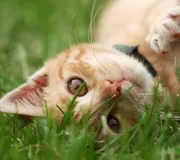Our canine companions come in all shapes and sizes. Big, small, sleek, fluffy, we love them all! One of the most beloved and unique-looking pooches is the pug. Fido’s adorable face and expressive eyes have definitely earned him some fans! A veterinarian discusses the pug below.
History
Pugs were originally bred as companion dogs for ancient Chinese nobles, including several Emperors. As one might expect, being the Emperor’s favorite pet is a pretty sweet deal. Those lucky pugs lived lives of complete doggy luxury, and even had their own guards. Pugs were also beloved in Tibet, where Buddhist monks kept them as pets.
Fido was brought to Europe in the 16th century, where he soon charmed … well, pretty much everyone, including Goya, the famous painter, who painted several pugs. Italian pugs were allowed to ride in the front seats of private carriages, often dressed in tiny replicas of the coachmen’s outfits. Queen Victoria was also a big fan. Pugs even became the official dog of the House Of Orange, after one pup alerted his owner, the Prince of Orange, to approaching assassins, thereby saving his life.
America
Fido made it over to the US in the 19th century. The AKC officially welcomed him into their ranks in 1885. In 1931, he got his own club: The Pug Dog Club Of America. One special pug, Dhandys Favorite Woodchuck, even won the Westminster Kennel Club Dog Show in 1981.
Care
Pugs are brachycephalic, which means they have very short airways, and can easily get out of breath. You don’t want to overexert Fido, as this can cause respiratory distress. However, you also shouldn’t let him become a complete couch potato: that can lead to obesity, which in itself can cause or contribute to a whole slew of health issues. You’ll also need to be careful with your pet’s eyes, as those bulging ‘bug eyes’ can be prone to injuries. Ask your vet for specific care tips.
Temperament
Friendly and lovable, pugs have often been referred to by the phrase Multum in parvo, which translates to ‘a lot of dog in a small space’ in pug Latin.They can be stubborn, but are rarely aggressive, and are remarkably patient with children, and are equally fond of naps and playtime. They’re often called shadows, because they stick so close to their humans.
Our Advice on Meet The Pug in 2024
What are the origins of the pug breed?
The pug breed originates from ancient China, where they were cherished companions of Chinese nobles, including Emperors. They lived lives of luxury, even having their own guards. Pugs were also esteemed in Tibet by Buddhist monks. They later gained popularity in Europe, charming figures like the famous painter Goya and Queen Victoria. In the US, they were officially recognized by the AKC in 1885 and formed their own club in 1931. Pugs have a rich history steeped in companionship and loyalty, making them beloved pets worldwide.
What are the specific care needs of pugs?
Pugs require special care due to their brachycephalic (short-nosed) anatomy, which can lead to breathing difficulties. They shouldn’t be overexerted to avoid respiratory distress but also need regular exercise to prevent obesity-related health issues. Additionally, their prominent eyes are prone to injury and need careful attention. Regular vet check-ups are crucial for monitoring their health and addressing any breed-specific concerns. Pugs thrive in a loving environment with balanced activity levels and attentive eye care to ensure their well-being and longevity.
How big do pugs typically get, and what are their standard coat colors?
Pugs typically weigh between 14 to 18 pounds and stand about 10 to 13 inches tall at the shoulder. As for coat colors, they come in various shades, including fawn, apricot, silver, and black. The American Kennel Club recognizes these colors as standard for pugs. Coat patterns may include black masks or markings, adding to the breed’s unique appearance. Understanding these typical characteristics helps pug owners ensure they’re providing appropriate care and meeting their pet’s needs.
Besides breathing and eye problems, are there other health conditions pugs are predisposed to?
Pugs are prone to several health conditions beyond breathing and eye problems. Their unique anatomy predisposes them to issues like skin fold dermatitis, which can result from the folds in their skin trapping moisture and bacteria. Additionally, pugs are susceptible to obesity due to their love of food and tendency to become sedentary. This breed also commonly experiences orthopedic issues such as hip dysplasia and patellar luxation. Regular veterinary check-ups and proper care can help manage these conditions and ensure the well-being of your pug companion. If you have concerns, visit our veterinary clinic in Treasure Coast, FL for expert advice.
Do pugs have specific grooming needs, like wrinkle cleaning or shedding management?
Pugs do have specific grooming needs. Regular cleaning of their facial wrinkles is essential to prevent skin fold dermatitis. Brushing their coat regularly helps manage shedding, which can be moderate to heavy, especially during seasonal changes. Pay attention to their ears, keeping them clean and dry to prevent infections. Additionally, maintaining their dental hygiene is crucial as pugs are prone to dental issues. Professional grooming may also be necessary for nail trimming and anal gland expression. Proper grooming not only keeps your pug looking their best but also contributes to their overall health and well-being.
Do you have questions about pugs? Contact us, your animal clinic in Treasure Coast, FL!

